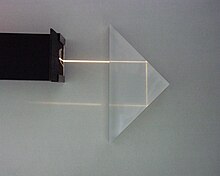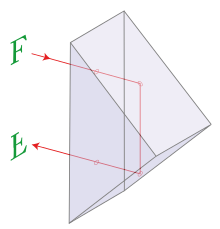In optics, a Porro prism, named for its inventor Ignazio Porro, is a type of reflection prism used in optical instruments to alter the orientation of an image.


Description edit
It consists of a block of material shaped like a right geometric prism with right-angled triangular end faces. In operation, light enters the large rectangular face of the prism, undergoes total internal reflection twice from the sloped faces, and exits again through the large rectangular face. When the light enters and therefore exits the glass at normal incidence, the prism is not dispersive.
An image travelling through a Porro prism is rotated by 180° and exits in the opposite direction offset from its entry point.
While a single Porro prism can be constructed to work as well as a roof prism, it is seldom used as such. Therefore, to reduce the cost of production for a Porro prism, the edge of the roof is usually left out. Sometimes only one small window as an entrance surface and one window as exit surface are polished. The distinction between a roof prism and a Porro prism is that for the roof prism the roof edge lies in the same plane as entrance and exit beam, while for a Porro prism the (left out) roof edge is orthogonal to the plane formed by the beams. Furthermore, the roof prism has no displacement and a deviation typically between 45° and 90°, while in a single Porro prism the beam is typically deviated by 180° and displaced by a distance of at least one beam diameter.
Porro prisms can reflect light rays that are not parallel to the optical axis in such a manner that they are internally reflected off the hypotenuse of the prism. Such an abaxial ray then emerges from the prism having been reflected a third time, thus introducing non image-forming stray light and reducing contrast. Abaxial reflections can be eliminated by putting a groove or notch across the width of the hypotenuse face center of the prism, which blocks these detrimental reflections.
Double Porro prism or Porro 1 optical system edit
Porro prisms are most often used in pairs, forming a double Porro prism. A second prism rotated 90° with respect to the first, is placed such that light will traverse both prisms. The net effect of the prism system is a beam parallel to but displaced from its original direction, with the image rotated 180°. A double Porro system provides four internal reflections. Since the light is reflected an even number of times, the image's handedness is not changed.
Double Porro prism systems are used in small optical telescopes to re-orient an inverted image (an arrangement is known as an image erection system), and especially in many binoculars where they both erect the image and provide a longer, folded distance between the objective lenses and the eyepieces. When there is an air gap between the two prism there are four glass/air transition surfaces.
Sometimes, the two components of the double Porro system are cemented together, and the prisms may be truncated to save weight and size and reduce glass/air transition surfaces to two and hence light transmission loss.
Porro 2 optical system edit
There is also a Porro prism of the second type [1] variant, which consists of three prisms of different shapes that can be and commonly are cemented together and also deflects the beam path four times by 90°. A double-reflecting half-cube prism is placed between two smaller, only once-reflecting half-cube prisms. The principal sections of the outer prisms are arranged at right angles to the central prism.[2] Its advantage is that there is no vertical offset of the beam path. Porro prism of the second type optical systems are not very common and generally applied in larger and military binoculars.[3][4][5]
Porro–Abbe and Porro–Perger optical system variants edit
Another variant of the Porro prism of the second type with the same function is the Porro–Abbe prism; a two prisms variant that reduces the lateral beam axis offset by 23% compared to a traditional double Porro prism system in binoculars.[6][7]
The Porro–Abbe two prisms variant has been further developed into the Perger prism, which combines the properties of Porro and roof top prism, requiring only a small offset of the beam path and also enabling a measuring beam or an illuminated display to be reflected through the changed angle of the reflection surfaces and the cemented surface. As of 2013 Perger prisms are commercially used on a small scale in Perger–Porro prism system binoculars with integrated laser range finders.[8][9]
Binoculars edit
Traditionally binoculars used a double Porro prism design, which resulted in a distinctive offset, zig-zag shape. Roof prism designs allow a simpler exterior, and are now common but they are more expensive to produce. Complicating production requirements make high-quality roof prism design binoculars relatively costly to produce compared to in optical quality equivalent Porro prism binoculars.[10][11][12][13] Good-quality Porro prism design binoculars often feature about 1.5 millimetres (0.06 in) deep grooves or notches ground across the width of the hypotenuse face center of the prisms, to eliminate image quality reducing abaxial non image-forming reflections. As human eyes are ergonomically limited by their interpupillary distance the offset and separation of big (60+ mm wide) diameter objective lenses and the eyepieces becomes a practical advantage in a stereoscopic optical product.
In the early 2020s the commercial market share of Porro prism type binoculars had become the second numerous compared to other prism type optical designs.[14]
Use in cameras edit
Most single lens reflex cameras use a roof pentaprism, and therefore have a distinctive top "peak". By contrast, a Porro prism allows a much tidier design, as used in the following models:
- Olympus Pen F, FT and FV
- Olympus E-300
References edit
- ^ Heinz Haferkorn: Optics - physical-technical basics and applications. Barth, Leipzig 1994, ISBN 3-335-00363-2, p. 485.
- ^ OPTI 421/521 – Introductory Optomechanical Engineering 5. Prisms, page 10
- ^ U-boat binoculars and other naval binoculars of World War II
- ^ U.D.F. 7 × 50 blc U-boat sight for torpedo firing By Anna and Terry Vacani
- ^ OPTI 421/521 – Introductory Optomechanical Engineering 5. Prisms, page 10
- ^ Binocular Optics and Mechanics Chapter from Binocular Astronomy by Stephen Tonkin, page 14 – 16
- ^ OPTI 421/521 – Introductory Optomechanical Engineering 5. Prisms, page 10
- ^ EP2463692B1 Prism European Patent Office
- ^ Binoculars dealer summary, showing 10 listed Porro-Perger prism designs and 1,006 binoculars that use other optical designs in May 2022
- ^ Why do the best roof-prism binoculars need a phase-correction coating?
- ^ Thompson, Robert Bruce; Thompson, Barbara Fritchman (2005-06-24). Astronomy Hacks, chapter 1, page 34. "O'Reilly Media, Inc.". ISBN 9780596100605. Retrieved 2009-11-03.
- ^ Binocular Optics and Mechanics Chapter from Binocular Astronomy by Stephen Tonkin
- ^ Porro Prism Binocular a Best Buy by Ron Spomer
- ^ Binoculars dealer summary, showing 239 listed Porro prism designs and 777 binoculars that use other optical designs in May 2022